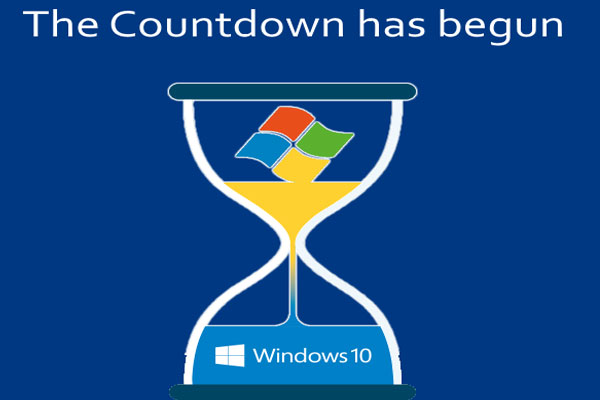The End of Microsoft’s Windows 7

Windows 7 OS Enters Final Year of Free Support
Windows 7’s five years of extended support will expire on January 14, 2020. After this date, security fixes will no longer be freely available for the operating system that’s still widely used. If you still use Windows 7, it may be time to consider an upgrade.
“Changes and upgrades in technology are inevitable,” said Brad Anderson, corporate vice president for Microsoft 365, in a blog. “And there’s never been a better time to start putting in motion the things you need to do to shift your organization to a modern desktop with Microsoft 365.” Microsoft will continue to provide security updates for Windows 7 to business customers that pay for support, according to ZDNet, but not individual users.
Windows 10
Windows 7 was released in 2009 and is still one of the most widely used desktop operating systems. Windows 10 finally overtook Windows 7 in the desktop market at the end of last year, according to ZDNet. Data analysis reports for December 2018 showed that 39.2 percent of the machines they collect data from used Windows 10, while 36.9 percent used Windows 7, according to ZDNet.
What Does End of Support Mean?
The end of free support does not mean the end of support entirely. Microsoft has long offered paid support options for its operating systems beyond their normal lifetime, and Windows 7 is no different. What is different is the way that paid support will be offered. For previous versions of Windows, companies had to enter into a support contract of some kind to continue to receive patches. For Windows 7, however, the extra patches will simply be an optional extra that can be added to an existing volume license subscription. No separate support contract will be needed on a per-device basis. These Extended Security Updates (ESU) will be available for three years after the 2020 cut-off, with prices escalating each year.
Alternative Option
According to Microsoft Technologist Peter Bright, as an alternative, Microsoft is offering all three years of ESUs to customers of the new Windows Virtual Desktop (WVD) service at no extra cost. This service offers cloud-hosted virtual machines running Windows 7 plus whatever applications are needed, and those virtual machines will continue to be patched into 2023. WVD uses existing Windows Enterprise E3 licenses, and it runs on the full range of Azure virtual machines, with no additional costs incurred. This includes, for example, GPU-equipped VMs, meaning that WVD should be usable for a wide range of workloads.
Office 365 will continue to be supported on Windows 7, but only with the ESUs applied. Similar policies exist for Windows Server 2008 and Windows Server 2008 R2. These also drop out of free support in one year. For on-premises deployments, customers will be able to buy the Extended Security Updates, but workloads in Azure will receive all three years of fixes for free.
Here are a few reasons why Windows 10 is superior to Windows 7:
- Multitasking – It is much easier to juggle multiple open windows when you’re working. Features include offering both half-monitor and quarter-monitor sizes when you drag a window to one part of the Desktop. Other open windows are able to fill any open space automatically. One can view a much clearer thumbnail overview of your open windows and supports multiple Desktops. This makes working with full-screen windows much easier when you don’t have multiple monitors
- Always up to date – It’s no longer possible to forget to run Windows Update. You will be less likely to miss a critical operating system patch that fixes a serious security problem. By forcing all users to stay up to date, everyone’s online safety is improved. It reduces the risk of a PC being compromised by a hacker and becoming part of a botnet that could be used to attack your PC.
- Security – The safety of your PC is improved. With alternatives to a simple password, such as using a familiar picture, it makes it much harder for anyone to sign into your PC without your permission.The new PIN system also means you can protect your Microsoft account with a long, strong and very secure password, but still use a simple PIN code to sign into your PC — and it only works on your PC.
- New Windows Features – Digital assistant Cortana is gradually improving with every update, while the Action Centre is a neat and tidy place to keep all your notifications.
- Faster – Performance tests have shown that this version is faster across the board than earlier versions of Windows. It boots, goes to sleep and wakes from sleep marginally faster than it would on a PC of the same specification. This means less waiting around when you want to do something. Application performance is more of a mixed bag. Tests show it to be faster than Windows 7 with some apps and slower with others. Bear in mind that Microsoft will update Windows 10 regularly. Windows 7 is now essentially frozen in its current state after ‘mainstream’ support ended in January 2015.
Contact Zunesis if your organization is interested in moving from Windows 7 to Windows 10. We can provide support and expertise during the transition.
Categories
Search
Blog Categories
Related Resources
Archives
- July 2024
- June 2024
- May 2024
- April 2024
- March 2024
- January 2024
- October 2023
- September 2023
- August 2023
- July 2023
- June 2023
- May 2023
- April 2023
- March 2023
- February 2023
- January 2023
- October 2022
- July 2022
- June 2022
- May 2022
- April 2022
- March 2022
- February 2022
- January 2022
- December 2021
- November 2021
- October 2021
- September 2021
- August 2021
- July 2021
- June 2021
- May 2021
- April 2021
- March 2021
- February 2021
- January 2021
- December 2020
- November 2020
- October 2020
- September 2020
- August 2020
- July 2020
- June 2020
- May 2020
- April 2020
- March 2020
- February 2020
- January 2020
- December 2019
- November 2019
- October 2019
- September 2019
- August 2019
- July 2019
- June 2019
- May 2019
- April 2019
- March 2019
- February 2019
- January 2019
- December 2018
- November 2018
- October 2018
- September 2018
- August 2018
- July 2018
- June 2018
- May 2018
- April 2018
- March 2018
- February 2018
- January 2018
- December 2017
- November 2017
- October 2017
- September 2017
- August 2017
- July 2017
- June 2017
- May 2017
- April 2017
- March 2017
- February 2017
- January 2017
- December 2016
- November 2016
- October 2016
- September 2016
- August 2016
- July 2016
- June 2016
- May 2016
- March 2016
- February 2016
- January 2016
- December 2015
- October 2015
- September 2015
- August 2015
- July 2015
- June 2015
- May 2015
- April 2015
- March 2015
- February 2015
- January 2014
- February 2013




